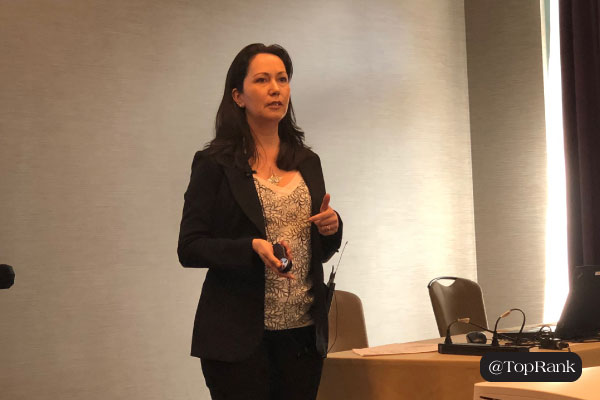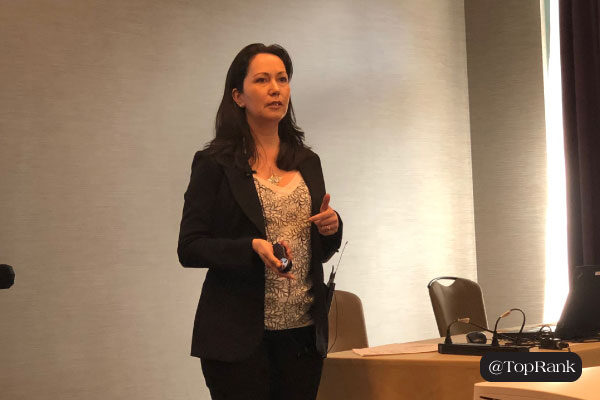
Standing before a room of eager-to-learn marketers at B2B Marketing Exchange, Liz Cope, Director of Marketing Technology and Operations at Ingersoll Rand, was an open, honest, vulnerable … human.
“This is so embarrassing,” she said, admitting that some fundamental marketing functions were missing the mark at her multi-billion-dollar company.
Liz’s candor helped audience members feel right at home and not alone. After all, we’ve all been disappointed to learn that one of our core marketing functions or strategies needed to be reworked, rebooted, or reimagined entirely. Her candid approach also tied well into her session’s theme: Martech, Process and People: Humanizing the Journey to Channel Transformation.
Liz’s presentation was robust, detailing key technologies, processes, and the organizational structure she and her team have put in place to transform their channel marketing strategy. But her message was simple: Automate to humanize.
And in a time where marketers are being challenged to deliver more personalized, customer-centric experiences to create connections and drive results, this premise deserves consideration.
The Real Value of Martech & Automation is Human
Marketing technologies exist to automate time-consuming processes; to eliminate and alleviate the level of human touch necessary to complete a task or series of tasks, while also delivering more intelligent insights. So, how can automation be a gateway to humanization? The answer is quite simple, for Liz and her team.
“We can use martech to automate work for our internal employees and channel partners to free them up to engage in valuable human interactions with customers,” she stated. “We can automate to humanize our brands.”
And they’ve put this mantra in action.
The Humanizing Journey
Ingersoll Rand, a manufacturing company that’s been in business for more than 130 years, gets most of its sales and revenue through indirect distribution channels—meaning the company has to manage a global network of distribution partners.
To arm those channel partners with the tools they need to be effective and successful, Liz and her counterparts have been working hard to ensure the right marketing technologies, processes, and people are in place.
Another major driver of their hard work is the desire to build a customer-focused business. According to Liz, a new batch of research shows that companies that are perceived as easier to do business with will have three-times more share-of-wallet in the future. And Ingersoll Rand wants to capture that share.
“When we’re genuinely invested in our customers—invested in putting them first—we can gain their trust. And we can earn their confidence and mindshare to increase our market share and share-of-wallet,” Liz declared.
So, where are Liz and her team at on their “automate to humanize” journey and what results have they seen?
While Liz admits they’re just getting started, they’ve begun by focusing on two improvement opportunities:
- Improving lead management. On average, it was taking at least three days for leads to get routed to the right partner.
- Enhancing accessibility to marketing collateral. According to Liz, there were several different systems being used to provide resource materials, each requiring a separate login and password.
Here’s what they’ve done:
- When it comes to technology, they’ve implemented a partner relationship management (PRM) system to automatically route leads to partners and house an asset library. As for initial results, the ability to automatically route leads has reduced internal effort by an impressive 30%. In addition, they now have more visibility into how partners are consuming content, so they can personalize communications and support on the go-forward. Finally, they’re in the midst of a martech stack evaluation to understand where there is overlap, gaps, and the most value to be gained.
- When it comes to process, they’ve identified key priorities to keep them focused and enhance their ability to scale efforts across the organization. For example, they’re building out a “marketing standard work” framework to ensure employees know what steps to take when executing work.
- When it comes to people, they’ve constructed an organizational structure that allows collaboration and visibility at multiple levels. For example, they’ve established a Marketing Leadership Council to act as a steering committee.
The B2B Marketer’s Takeaway
If your organization wants to become truly customer-focused and deliver more personalized experiences, you need to enable your internal team, partners, and customers to be successful.
While Liz’s insights came from work to transform a channel strategy, any B2B marketer has the opportunity to ensure the right people, processes, and marketing technologies are in place to deliver content and experiences that empower their audiences, humanize their brands, and create efficiencies at scale.
For more insights from the conference, you can follow @toprank, @leeodden, @azeckman, and @CaitlinMBurgess on Twitter. Stay tuned for more by following the blog here.



